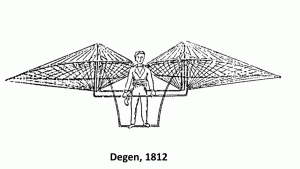Continuing with the flapping-wing theme, in 1812 a clockmaker from Vienna named J. Degen amazed readers across Europe when he claimed to have flown to the breathtaking altitude of 54 feet in the apparatus shown below. Apparently he was able to wave and wiggle the umbrella-shaped wings enough to reach a pretty impressive height. It’s almost enough to make me want to build one.
BUT… there’s a catch. What Degen failed to mention, either in his drawings or his newspaper articles, was that his apparatus was also attached to a small balloon. And by “small” I mean a balloon capable of providing 90 lbs of lift. When audiences pointed out the balloon and said “Hey, what does that do?”, he tried to explain that it was only needed “as a counterpoise to maintain his equilibrium,” and was in no way responsible for his actual flights. Sure, we’ll just ignore the man behind the curtain, amirite?
This explanation was about as convincing as you might expect, and after a failed exhibition in Paris, Octave Chanute’s account says Degen was “attacked by the disappointed spectators, beaten unmercifully, and laughed at afterward.”
Beaten and laughed at? By Parisians? Bummer, man.
LESSON: Honesty matters in innovations & designs! If most of your lift comes from a balloon, don’t claim it’s from your flapping wings.